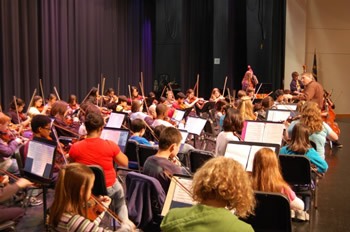The Salisbury Symphony brought in a great crowd for their “Dream of America” concert at Catawba College. This being my first time at a Salisbury Symphony concert, I was thrilled to see such a large turnout and thoroughly appreciated the sense of community and hospitality from attendees. As the third concert I’ve attended this month built around Americana, I was curious to see how the Salisbury Symphony’s programming would compare to Winston-Salem Symphony’s all-American concert and the North Carolina Opera’s premiere of Sanctuary Road. Opening with Dvořák’s Symphony No. 9 “From the New World” and closing with Peter Boyer‘s Ellis Island: Dream of America, the orchestra appealed to a sense of patriotism and belief in the “American Dream.”
There was much to enjoy about the Salisbury Symphony’s performance of Dvořák’s Symphony No. 9. I found the extensive English horn solo in the second movement to be tastefully understated and simple in a way that accentuated its natural, vocal quality. Also in the second movement, the two covered clarinet duets struck me with their sensitivity to melodic and harmonic priority. There were however a handful of unfortunate lapses in the performance. Some inconsistent intonation and coordination from a member of the horn section, timing delays between strings and winds in the third movement, and several tempi that struck me as rather sluggish for my expectations of this symphony took me out of the moment. In regards to programming, Dvořák’s “From the New World” is a thoroughly entertaining work to play and to listen to, but I don’t know if it’s the best choice for an American-themed program. With such a wealth of American composers to choose from, I believe that putting Dvořák on an American-themed concert is a bit of a disservice. However, for many in the audience, this may have been their first exposure to Dvořák 9. Taking that into consideration, I’m grateful for the Salisbury Symphony’s mission of bringing “the joy of music to anyone willing to listen.”
Following Dvořák, Boyer’s Ellis Island: Dream of America was the cornerstone piece of the evening. Composed in 2001-02, the work is a multimedia combination of instrumental interludes, historical photography from Ellis Island, and a collection of interviews from immigrants as part of the Ellis Island Oral History Project. After a musical opening-of-the-curtains, many of the interludes portray the narrative elements of the included stories. The orchestra realized the ominous sound of an escape from war-torn Europe, and the surging waves of the unruly storms immigrants experienced on their seaborne journeys. As well as the orchestra executed the work and as idealistic as the narrative is, I did feel that the story lacked an element of representation. Of the seven interviews recounted in the piece, all of them came from white-presenting European immigrants even though the Oral History Project includes testimonies from Chinese, Brazilian, Haitian, and Syrian immigrants to name a few. Especially when immigration and refugee crises are such relevant topics in political discourse, there should be music and testimonies that better represent the climate of the present, especially when the piece concludes with a recitation of Emma Lazarus’ poem “The New Colossus,” which is inscribed on the Statue of Liberty. As Lazarus proclaims, “The Mother of Exiles” beckons with silent lips: “give me your tired, your poor, your huddled masses yearning to breathe free,” and “send these, the homeless, tempest-tost to me.”
During the intermission, conductor David Hagy honored three retiring long-time members of the orchestra in a touching ceremony. The final acknowledgement went to Leroy T. Sellers, who after 55 years as a violinist with the ensemble was recognized with an endowed seat in his name. Although I found some disagreement with the concert’s programming, the words of wisdom Sellers shared with the audience reassured me of the ensemble’s vital role in the community. Sellers spoke about how it was music that kept him out of trouble as a kid and that as a community, we can help youth by continuing to fund the arts. Sellers also voiced his admiration for the young people in the ensemble who are practicing like crazy and making a living playing “in the sticks.” Even if I found parts of the concert a bit lackluster, I think it’s wonderful that the Salisbury Symphony is an organization that is able to serve the tastes of their audiences and the needs of their musicians.
Overall the concert was good; the technique and quality of sound from each section was laudable, and the musical expression of the orchestra bloomed as the concert progressed. Programmatically speaking, I think the Salisbury Symphony missed an opportunity to present a more nuanced and impactful performance to the stage. With such a devoted community of attendees, I think the Salisbury Symphony has the rapport necessary to engage with their listeners in a deeper, more relevant fashion.












